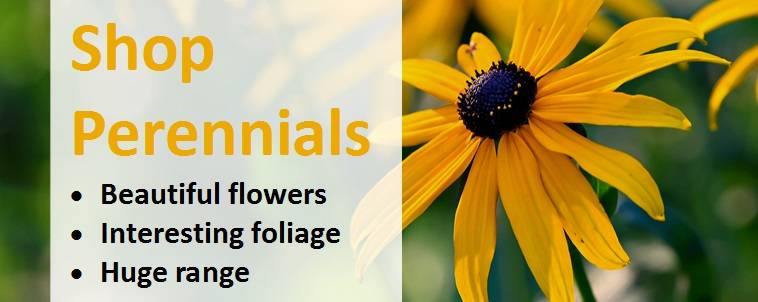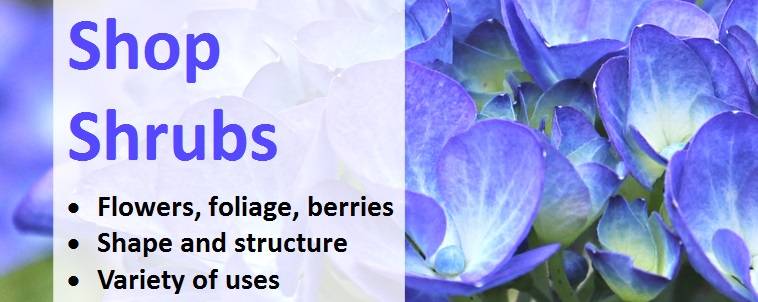Check Here Before Buying – Pot Size Matters...Not all websites offer the same. Plants in a 2-litre pot have twice the root system of a P9 or 1 litre pot.
Guide to Starting a New Garden
There are many things to consider when starting a new garden. You have to select the correct plants for your garden conditions, decide what theme or style you wish to follow, if any, and choose the ultimate purpose of your garden. Is it to be a produce garden for fruits, herbs and vegetables? A cottage garden to be enjoyed? A tropical display to be marvelled at? Or an area with open lawns and trees for children to play in?
As with any creative endeavour, you need an idea to inspire you. Browse the web, flick through magazines, and even create a scrapbook or mood board to help you realise your final, creative vision. With such a wide range of inspiring and informative sources, and a plethora of plants to choose from, the world is your oyster!
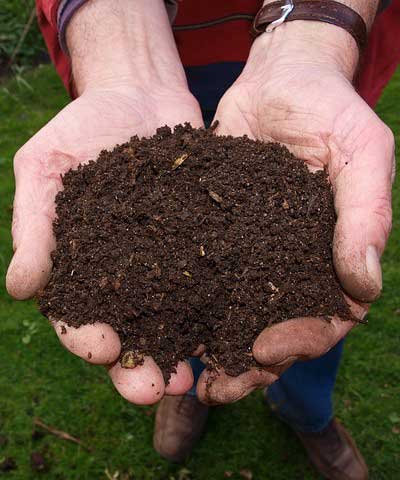
Phase One: Preparation
- Assess any constraints you may have. How hardy will your plants need to be? Is the area prone to hard winter frosts which will kill smaller, non-hardy plants? Do the plants need to be drought resistant? Flood resistant? Are there any pests that your plants need to be safeguarded against? Examine your space and conduct research about specific types of plants that will be suitable for your garden.
- Consider what kind of garden you want, and therefore what to retain in your existing plot. Many gardeners want a large area for planting fruits and vegetables, whilst families may want hard-wearing lawns and hedges for privacy. If the plot already has the features that you desire, then it makes sense to leave them as they are. If not, this can be assessed in the planning phase.
- Always inspect lawns. If poorly laid, defects are almost certain to appear. If the ground underneath the lawn is heavy clay, it may deteriorate in the winter. If the ground is sandy, the lawn will become starved and prone to drought. If needs must, lift the existing turf, prepare the site, and relay it or buy new turf after preparations are complete if you have to.
- Identify and check any existing trees and shrubs. Only smaller trees are suitable near buildings, and taller trees that are situated a few meters from the house should be removed as soon as possible.
- Inspect the site in both wet and dry weather. If it shows signs of waterlogging, it may be necessary to install drainage. If it is prone to drying out, irrigation may be needed. See what works best for you and your plot, and adapt your methods accordingly.
- A soil analysis may be required to provide information about your soil type, texture, pH, organic matter content and major nutrients present in the soil. This will also help inform you about what action to take if any. Also bear in mind that while some plants thrive in say, acidic soil, others will not take kindly to it. Always consider your soil when selecting plants for your garden.
- Soils on newer builds will be low in nutrients due to the heavy volume of work traffic that has been conducted throughout construction. Rubble and other excess materials may have also been offloaded onto the ground, making it barren and unsuitable for planting. To address this, spread whatever organic matter is available over the soil, and apply a fertiliser. You may also wish to purchase an additional topsoil—but it must meet British Standards. You can request a sample for your approval ahead of making a final decision.
Phase Two: Planning
- Not only do you need to prepare your plot to take on a new garden, you also need to prepare designs and plans for the new garden.
- Many people decide to employ a garden designer or landscaper, or purchase books on the subject in order to get a better idea of what plans need to be drawn up.
- Create a scale drawing of the plot on squared A3 paper. Use a compass, and record the direction the garden faces. Plot out the garden using pegs and a tape measure, then add features as you see fit. Experiment until you are happy with the final design.
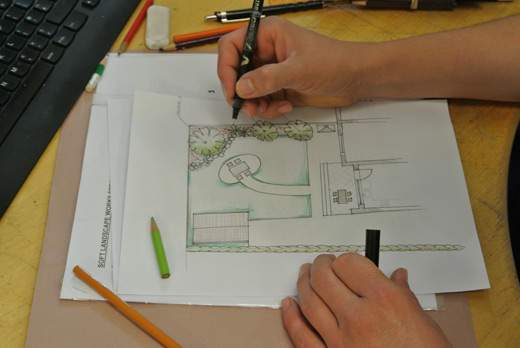
Creating good quality drawings will really help moving forward
There are many different classifications of garden style. The most popular include urban gardens, wildlife-friendly gardens, Mediterranean gardens, contemporary gardens, formal gardens and cottage gardens. Of course, you don’t have to adhere to a specific style, and may mix and match styles as you please. However, below is an overview of what you would expect from each specific style.
Urban Gardens
City and urban gardens are amongst the trickiest to design, but as a result of their limitations, the designer can be forced to think ‘outside the box’, thus creating a stunning garden. Usually taking up a small space, city gardens need innovative and clever thinking to make them work well. Most urban gardens become functional, plant-filled, multi-purpose havens that provide an escape from city life. Plants such as Japanese Acers, the Acanthus Mollis and climbers such as Clematis and Hedera are perfect for urban gardens, providing colour, texture, structure and even shelter in the small space.
Wildlife-Friendly Gardens
Wildlife-friendly gardens feature plants and structures that are attractive to native wildlife and insects. Log piles, bee hotels, bird boxes and hedgehog lodges will bring a variety of wildlife to your garden. Many plants appeal to pollinating insects, and the best part of all is that you can create a wildlife garden even in small spaces. Plants such as Buddleja, Campanula and Escallonia are perfect for attracting, bees, birds and pollinators to the garden.
Mediterranean Gardens
Mediterranean gardens can be formal or informal, and take their inspiration from the hot, dry climates of Spain, Italy and France. They are usually full of drought-tolerant plants such as lavender, olive trees, rosemary, and climbing vines. This style can adapt well to the cooler climates of British ground, but a lot of Mediterranean plants dislike cold, wet winters and will need protection throughout the cooler months.
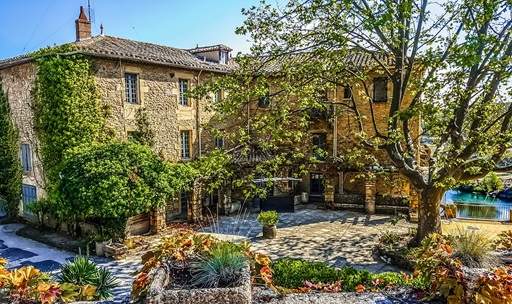
Mediterranean Style Garden
Contemporary Gardens
Crisp, clean lines are a pivotal part of contemporary garden design. The main detail in contemporary gardens is the lack of clutter and fussy details. Intricate, detailed flowers and plants have no place here unless they are teamed with a dramatic backdrop of black granite and deep purple foliage. Perfect plants for this garden include hostas, heucheras and crocosmia. Team these plants with materials such as slate, wood and stone and beautiful water features or reflection pools to create a contemporary garden.
Formal Gardens
Formal gardens must have a balanced design and contain symmetrical aspects. A formal garden often includes seating, water features and plants that create structure and form. Topiary trees and laurels provide structure and detail, while clusters of cool-coloured flowers such as agapanthus and campanula make for a beautiful small detail.
Cottage Gardens
Known for their quintessential English style and abundance of mysterious, fragrant blooms, the cottage garden evokes feelings of fantasy and fairy tales. Abundant planting that spills over onto narrow pathways is key here, as are fruit trees, herbs and pretty flowers such as peonies and rose bushes. Whatever you choose to plant in a cottage-style garden, it must meet the typical English, romantic aesthetic.
Phase Three: Hard Landscaping and Selecting Plants
Before you begin work on your garden, you must consider the need for any hard landscaping work. If the site slopes steeply, it may be necessary to put in retaining walls. Some people prefer to undertake this task themselves, where others employ a qualified builder or landscape contractor.
You may also want to add a fence to your garden. Remember that fences above 6ft (1.8m) require planning permission.
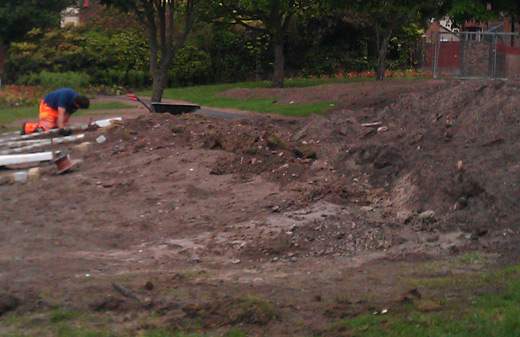
Sometimes hard landscaping may be required to bring an idea to life
- After the consideration for hard landscaping has been undertaken, it is time to start selecting your plants. While you may wish to adhere a specific garden style as outlined above, the final decision of what plants to select comes down to two main factors: do you like it? And will it survive in your garden conditions? If the answer to both of those is ‘yes’, then you should select the plant in question.
- Remember to consider when and where you want colour or interest in the garden. Plants can provide spring, summer, autumn and winter interest, so choose when you would like to see colour or interest and find plants that adhere to your specifications.
- Also, remember to choose trees carefully. Subsidence can occur when trees drain moisture from clay soil and foundations, and their roots can also grow into drains and cause blockages, which can burst as a result. If the drains are watertight, tree roots will generally not bother them.
Phase Four: Planting
After all your preparation is complete, your plans are laid, and your plants are selected, it is time for work to commence. Always choose the right plant for the right place! Use the site and soil as a guide. Plants either need to be drought tolerant, shade tolerant, suitable for coastal conditions, suitable for wet soils or suitable for clay soils. Sometimes, it can be a combination of a few of these factors. Use your better judgement, and ask for professional help or advice if you need to.
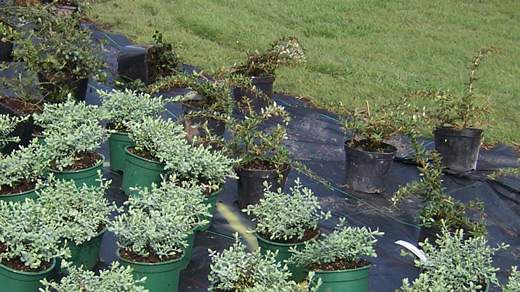
It often helps to lay out your plants to visual where they will be planted
Take care of the seasons when planting your new plants. Do not plant sensitive specimens in the winter; instead, wait until the risk of killing frosts and harsh winter conditions have passed. You can find information about recommended planting dates online, or you can ask a specialist for expert advice.
Phase Five: Aftercare
Even when all the initial work is finished and you can sit back and enjoy your new garden, your efforts never truly cease. There is always work to be done in the garden. Some plants are more demanding than others, and you will get into your own routine as you figure out what works best for you and your plants. You will learn the seasonal rhythms of your plants, and get to know all about any problems and how to fix them. Maintenance is the true essence of gardening and should be carried out as often as possible to ensure a long, healthy life for your plants.
Share this page:



